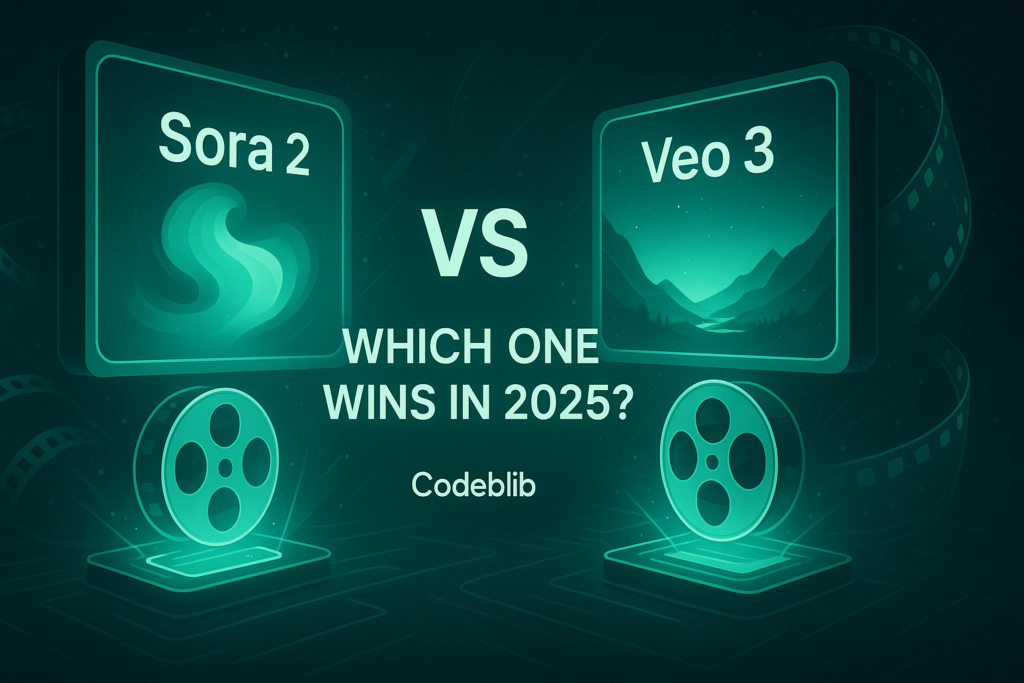Introduction
AI video generation tools are accelerating fast. In 2025, two models are getting major attention: OpenAI’s Sora 2 and Google / DeepMind’s Veo 3. Each brings unique strengths and trade-offs.
In this article, we’ll:
- Explore what Sora 2 and Veo 3 are
- Compare core features side by side
- Test real use cases and limitations
- Decide which tool has the edge depending on use case
Let’s get into it.
What Are They?
Sora 2 (OpenAI)
Sora 2 is the next evolution of OpenAI’s text-to-video model. It aims for improved realism, physical fidelity, and audio-video synchronization over its predecessor. OpenAI Help Center+3Krea+3Medium+3
Key capabilities:
- Supports text prompts, and can use input images or short video references to guide generation. Imagine Art+3Krea+3Medium+3
- Generates videos of up to 20 seconds in length (per OpenAI docs) while aiming to maintain prompt adherence and visual quality. OpenAI Help Center+2OpenAI+2
- Emphasis on physics consistency — e.g. modeling buoyancy, object motion, maintaining consistent world states. eWeek+2Medium+2
- “Cameo” feature: ability to inject a user’s likeness (face / voice) into generated videos (with consent). Krea+3Medium+3Business Insider+3
Veo 3 (Google / DeepMind)
Veo 3 is Google’s latest generative video model, integrated into Gemini / Google AI infrastructure. Axios+5Gemini+5Gemini+5
Some core features:
- Generates 8-second videos with native audio (dialogue, ambient sound, effects) by default. Medium+3Gemini+3DataCamp+3
- Strong prompt adherence and continuity across scenes. No Film School+4Google DeepMind+4blog.google+4
- Ability to use reference styles and visual anchors (images / video references) to maintain consistency. Pollo AI+2DataCamp+2
- Part of the Gemini AI platform; integration with Google AI, Gemini mobile, etc. Gemini+2Gemini+2
Feature Comparison
Here’s a side-by-side comparison of key aspects:
| Feature | Sora 2 | Veo 3 |
|---|---|---|
| Maximum Video Length | Up to ~20 seconds (per OpenAI) OpenAI Help Center+1 | 8 seconds (by design) Gemini+2blog.google+2 |
| Audio / Dialogue | Proposed, with synchronization improvements, though real-world lip-sync may vary Why Try AI+4Medium+4eWeek+4 | Native audio, ambient sound, dialogue built in by default Medium+5DataCamp+5Medium+5 |
| Physics & Realism | Strong physics modeling (objects move plausibly, world state consistency) Krea+3Medium+3eWeek+3 | Good visual realism, continuity; audio adds realism edge No Film School+3Axios+3Medium+3 |
| Prompt Fidelity | Good — complex prompts, multiple scenes accepted, but may trade off with realism in tricky cases Why Try AI+2TechRadar+2 | High — prompt adherence is a strength, especially in maintaining context over an 8-second clip Medium+2DataCamp+2 |
| Reference / Style Anchoring | Supports input images and clips to guide styles | Strong support for reference anchoring, style control Pollo AI+1 |
| Integration / Ecosystem | Part of OpenAI / Sora platform; may integrate with ChatGPT ecosystem | Tied into Google / Gemini / DeepMind ecosystem Gemini+2Gemini+2 |
| Limitations & Known Issues | Audio / lip-sync still maturing; prompt edge cases | Short duration; occasional prompt misinterpretations; sometimes audio or lip-sync issues Tom’s Guide+1 |
Use-Case Comparisons & Observations
To better see how they perform, consider these real-world comparisons:
1. Short Social Clips with Audio
- Veo 3 shines because audio is built-in. You can prompt “A person playing guitar with ambient crowd noise,” and Veo 3 aims to deliver that end-to-end. Axios+3DataCamp+3blog.google+3
- For Sora 2, while it’s capable of generating audio, audio fidelity / lip sync might lag in complex scenes. Medium+1
2. Longer Scenes / Multi-Shot Narratives
- Sora 2 has more headroom (20s) for creative storytelling with multiple cuts.
- Veo 3’s shorter 8s limit demands very tight, single-scene narratives, which may constrain ambition.
3. Physics / Realism Sensitive Scenes
- If you ask for “water splash, bounce, object gravity,” Sora 2 tends to better maintain physical realism and consistency across frames. Krea+2Medium+2
- Veo 3 is strong visually, but in very complex motion sequences, small continuity issues may creep in. No Film School+1
4. Prompt Complexity & Stylization
- Veo 3 handles complex prompts well, especially when you anchor style or reference images.
- Sora 2 is powerful but may need more prompt tuning when the prompt is very complex.
Limitations & Ethical Concerns
No tool is perfect. Here are caution areas for both:
- Bias & hallucination — AI can generate plausible but incorrect visuals or context.
- Misuse / Deepfakes — With audio and video, misuse risk amplifies.
- Copyright / likeness — Even if these models restrict certain prompts, the line between inspiration and infringement can be blurry.
- Access and cost — Veo 3 is behind Google’s premium tiers; Sora 2 access may also be gated. Gemini+1
Verdict: Which One Wins in 2025?
It depends on your priority:
- If audio, integrated sound, and ready-to-share clips are your top priority → Veo 3 likely has the edge in 2025.
- If you want longer scenes, advanced physics, styling control, and storytelling flexibility → Sora 2 is more promising (once matured).
Right now, for many social / marketing creators wanting quick video + audio, Veo 3 is more ready out of the box. But Sora 2 is more flexible for ambitious creators.
Internal Link Ideas (for Codeblib)
Closing Thoughts & Next Steps
The race between Sora 2 and Veo 3 is just beginning, with both models pushing what’s possible in AI video. In 2025, Veo 3 is ahead for polished, short audio-visual clips, while Sora 2 offers creativity and longer narrative potential.
I recommend testing both with your own prompts, analyzing their strengths in your niche, and combining them where needed.
Stay tuned to Codeblib, I’ll bring more comparisons, prompt recipes, and deep dives as these tools evolve.
